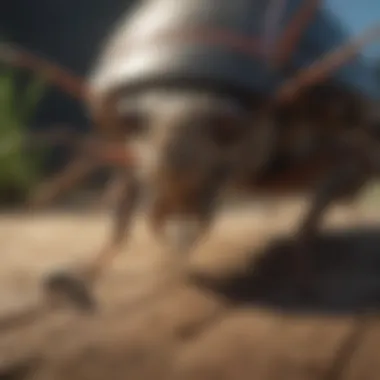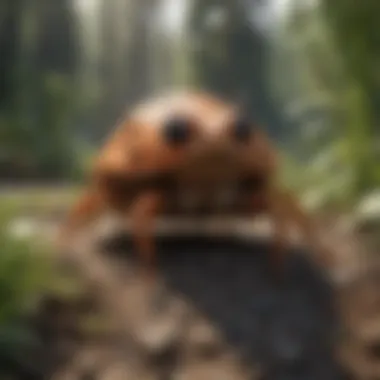Malphrus Pest Control: Strategies for Ecosystem Management


Preventive Pest Control Strategies
Preventing pests is the key to maintaining a healthy home and environment. To maximize success, one must adopt an integrated approach to prevention. The following practices address different aspects of pest control, ensuring a pest-free living space from the outset.
House Exterior Protection
The exterior of your home plays a vital role in keeping pests at bay. Simple measures can make a significant difference.
Tips for sealing cracks
- Check for cracks around windows and doors. Use caulk or weatherstripping to seal gaps effectively.
- Inspect the foundation. Use a concrete filler to seal larger cracks.
- Ensure that vents are covered with mesh. This prevents pests like rodents from entering.
Clearing debris
Thoroughly clear any debris from around your home. Piles of leaves, wood, or grass can provide perfect nesting spots for pests. Regularly maintain the area around your home by:
- Raking leaves and mowing grass
- Keeping firewood stored away from the house
- Disposing of bricks or soil timely
Preventing pests from entering
Create barriers that the pests cannot cross. Ensure doors and windows are closed and consider installing screens. An important protocol could also include inspecting items being brought into the home.
Yard Maintenance
Proper yard maintenance helps deter pests from taking up residence.
Essential yard care routines
Routine landscaping care is key. Establish regular mowing schedules, trim shrubs, and plant far enough away from walls. Furthermore, ensuring proper drainage is crucial to eliminate standing water.
Methods for keeping yard pest-free
Implement the use of beneficial plants. Certain plants such as marigolds, lavender, and rosemary confuse or repel pests. Also, regularly clean up fallen fruit or nuts which can attract insects and rodents.
Indoor Cleanliness
Keeping inside your home clean is equally important in the fight against pests.
Expert cleaning tips and techniques
Ensure that all areas of the home are regularly cleaned. Focus should especially be given to kitchens and dining areas where food particles can accumulate:
- Sweep and vacuum floors frequently.
- Store food in airtight containers.
- Clean food prep areas thoroughly after cooking.
Maintaining a pest-resistant indoor environment
Utilize natural repellents inside and ensure regular deep cleaning. Avoid clutter; pests thrive in hidden and cramped spaces.
Garbage Disposal
Efficient waste disposal is fundamental in pest prevention.
Efficient waste disposal methods
Promptly dispose of garbage or compost material. Seal food waste tightly in containers to eliminate odors or access.
Importance of proper garbage disposal
Improper waste management attracts pests. Keeping garbage bins closed and removing waste from your home regularly is very necessary.
Other Pest Prevention Strategies
Innovative methods further enhance a pest-prevention strategy.


- Regularly inspect your home for signs of pest activity.
- Use traps or barriers effectively.
- Educate yourself on pest behaviors to predict issues.
Effective prevention is always easier than dealing with an infestation. Knowing the strategies can ultimately save time and resources.
With these steps, pest control becomes a manageable process. The focus on prevention provides a solid foundation for the rest of your pest control efforts.
Preamble to Malphrus Pest Control
Understanding Malphrus
Malphrus refers to a genus of pest insects that have become increasingly relevant in agricultural sectors. These pests pose significant threats to crops, making effective control measures crucial. As homeowners and farmers unavoidably encounter these creatures, a comprehensive understanding of Malphrus becomes vital. Knowing the characteristics and behavior of these pests helps in anticipating their presence and mitigating their effects on resources. When recognizing Malphrus species, dwellers can take timely steps to reduce infestations, resulting in preserving both gardens and farms.
Importance of Pest Control
Pest control is essential for various reasons. Firstly, it helps maintain sanitary conditions in home environments. Pests such as Malphrus can carry pathogens. This poses a risk not only to personal health but also to that of the family. Furthermore, the presence of pests can lead to significant economic losses in agriculture. For instance, crops severely affected by pest activities may incur further costs for replacements and loss of revenue.
Sustainable pest control abides by principles that consider ecologicalbalance. Adopting an integrated pest management (IPM) approach discourses the intricate web between environment, agriculture and pest phenomena. With the methods tailored around the specific species like Malphrus, control strategies can be both productive and environmentally judicious.
Adopting efficient pest control practices today lays the foundation for agricultural sustainability tomorrow.
Biology of Malphrus Species
Understanding the biology of Malphrus species is key for effective pest management. By comprehending their behavior, life cycle, and ecological requirements, we enhance our capacity to control them and mitigate their impact, especially in agricultural contexts. This knowledge helps tailor pest control methods that are effective, economical, and environmentally friendly.
Taxonomy and Classification
Malphrus species belong to the genus Malphrus within the insect order Coleoptera, specifically in the family of Chrysomelidae, known as leaf beetles. Accurate classification is crucial. Identification often involves examining morphological traits.
The strategic significance of taxonomy applies to pest control. Differentiating species indicators allows for targeted measures, thus preventing misuse of control methods that may be necessary for particular species but harmful for others.
Life Cycle and Habits
The life cycle of Malphrus species comprises several distinct stages: egg, larva, pupa, and adult. These stages span various periods depending on environmental factors such as temperature and host availability.
- Egg stage: Eggs are typically laid in clusters on or near host plants.
- Larval stage: Larvae emerge and begin feeding on foliage, leading to definitive crop damage.
- Pupal stage: Larvae transform into pupae, a critical yet often overlooked stage in pest development.
- Adult stage: Adults continue to reproduce, perpetuating the cycle. Every stage interacts directly with surrounding agricultural practices and organisms.
Agricultural interventions can disrupt habitat cycles during the larval and adult stages, helping mitigate potential damage.
Environmental Preferences
Malphrus species typically thrive in environments configured with certain climate conditions. They often prefer warm, moist areas along with plants they can consume. Certain crops may draw specific Malphrus species, increasing the likelihood of infestation. Identifying these preferences pays off regarding pest management strategies.
Important factors impacting their environmental choices include:
- Temperature: They prefer higher temperatures, often escalating their activity in peaks of heat during the growing season.
- Moisture: Damp environments bolster their reproductive capacities, contributing to population growth.
- Host Availability: Specific plants that attract certain Malphrus species serve as essential indicators in monitoring crop health.
By understanding these conditions, farmers can enhance both preventative and reactive strategies.
Understanding the biology of Malphrus species is crucial to developing successful management practices, making ecology a focal point for pest control activities.
Impact of Malphrus on Agriculture
Understanding the impact of Malphrus on agriculture is crucial for farmers and homeowners alike. Pest control affects not just productivity but the overall health of farming ecosystems. Malphrus species, as pests, have direct impacts that can disrupt agricultural practices extensively. Ignoring these issues can lead to severe losses, making it vital to comprehend the multiple facets of this impact.
Crop Damage Assessment
Evaluating crop damage by Malphrus is not a straightforward task. Various factors influence the extent to which these pests impair crops. Key parameters include the type of crops affected, the life cycle of the pests, and their population density at given periods. Typically, lesser-known species of Malphrus can lead to observable changes in plant health.
Farmers often need to perform regular assessments. Some effective ways to approach this are:
- Visual Inspections: Regular field reviews help recognize early signs of damage like leaf discoloration or wilting.
- Sampling Methodologies: Using quadrat sampling methods provides accurate data on pest density and kinds involved.
- Monitoring Tools: Hi-tech tools like remote sensing can offer broader insights into crop conditions and pest presence.
A detailed understanding here is imperative. Ignoring such assessments can lead to a sudden infestation reaching a critical point. Accurate data enables informed decisions, allowing one to gauge when intervention is crucial.
Economic Consequences


The economic ramifications of Malphrus infestation extend far beyond direct crop loss. Effective interception could lessen indirect costs associated with pest management. Addressing an outbreak can indeed pose question on financial viability for many growers. Considerations leading to economic impact include:
- Lost Revenue: Decreased yields clearly translate into lower profit margins on harvest.
- Increased Control Costs: Expenses can escalate quickly with chemical applications, monitoring procedures, and necessary labor.
- Reputation Risks: Frequent infestations can raise red flags in market segments, impacting long-term selling capabilities.
There’s a substantial interplay between agricultural viability and Malphrus species.
Current Pest Control Strategies
Current pest control strategies are critical to maintaining the health of crops and the overall integrity of agricultural practices. This section explores various methods deployed against Malphrus infestations and outlines the significant considerations that a homeowner or housewife needs to keep in mind for effective pest management. Each approach has its advantages and specific applications, thus a well-informed decision demands careful evaluation of these aspects.
Chemical Control
Chemical control remains one of the most commonly used methods to address Malphrus populations. These chemicals, often referred to as pesticides, can provide rapid results in managing pest outbreaks. However, using them comes with a set of considerations. The primary benefit of chemical control is its effectiveness in quickly reducing pest numbers, allowing for greater productivity in agricultural settings. Transformative products, such as chlorpyrifos and imidacloprid, work by targeting the nervous system of pests, which leads to their mortality. This effectiveness can be particularly crucial during moments of infestation flare-ups when time is of the essence.
However, homeowners and agriculture professionals alike must also consider the potential consequences. The repeated use of chemicals can cause resistance in Malphrus species — making pests harder to eliminate over time. Moreover, inappropriate application can unintentionally affect beneficial insects and the surrounding ecosystem. Some chemicals may linger in the environment, posing risks to non-target wildlife and even human health. It is paramount to follow guidelines and recommended application rates meticulously.
Biological Control
Biological control employs natural predators or parasites to manage pest populations. This approach creates a balanced ecosystem without the drawbacks typical of chemical methods. For instance, introducing Geocoris bugs or parasitic wasps provides a sustainable method to keep Malphrus numbers in check over time. By targeting pesticide-resistant pests, adopting this method can yield synergistic benefits. Benefits of biological control include a focus on eco-friendly practices and nutrient recycling within an ecosystem. However, it does demand a thorough understanding of how introduced species will impact pre-existing ecological frameworks. This complexity necessitates careful planning to avoid unintended consequences. Rainfall patterns and temperatures can also impact the viability of predators, necessitating proper monitoring.
Cultural Practices
Cultural practices involve modifying the agricultural or home environment to make it less conducive to pest populations. Different cultural strategies can reduce the chances that Malphrus will thrive and inflict damage. These practical changes may include crop rotation, intercropping, and making deliberate decisions about planting schedules. For instance, alternating different crop species can interrupt the life cycle of Malphrus, thiyus diverting them from one food source to another. Alternatively, ensuring proper sanitation by removing plant debris can eliminate hiding places and breeding grounds for pests.
Adopting strong cultural practices brings several advantages. These proactive measures often reduce reliance on chemical inputs while promoting increased soil health. Therefore, while more labor-intensive than employing chemical measures, these practices lead to longer-term solutions and less risk of generating resistance.
Integrating chemical, biological, and cultural practices is vital, promoting a balanced approach to pest control.
Sustainable Approaches to Pest Management
Sustainable approaches to pest management are crucial in today's environment. They focus on balancing human needs with ecological preservation. Traditional pest control methods often prove effective in the short term but can result in long-term harm. As such, looking at sustainable practices not only helps control pests naturally but also protects beneficial organisms and reduces chemical inputs.
These sustainable strategies are often cost-effective as well, making them accessible to more individuals. Additionally, they consider the health of the ecosystem as a whole, which is vital for maintaining biodiversity.
Integrated Pest Management (IPM)
Integrated Pest Management (IPM) is a holistic approach that combines various control methods. It emphasizes understanding pest life cycles and natural enemies. An IPM program typically begins with prevention strategies. Homeowners can maintain healthy landscapes by choosing resilient plant types and adopting sound cultural techniques.
Monitoring is another key aspect of IPM. By regularly assessing pest populations, one can determine whether threshold levels have been reached. Employing non-chemical control methods as the first line of defense is often more beneficial than automatically reaching for pesticides. When chemical interventions are necessary, IPM suggests selecting targeted options that minimize exposure to non-target species.
Use of Organic Methods
Organic methods of pest management often focus on using naturally occurring substances instead of synthetic chemicals. These methods can involve biological controls, such as introducing natural predators or parasites. Furthermore, organic pesticides derived from neem oil or insecticidal soaps provide safe alternatives to conventional pesticides.
Additionally, promoting practices like crop rotation and the use of cover crops contributes to soil health. These practices create an environment that inherently resists pest problems while supporting beneficial organisms. This fosters a self-sustaining ecological balance, steering clear from destructive pest cycles.
Community Involvement in Pest Management
Engaging community members in pest management efforts is essential. Community participation can significantly enhance pest control measures embraced by households. For example, educational workshops can equip residents with knowledge about best practices in managing pests sustainably.
Creating local networks can allow homeowners to share pest reports, successful strategies, and even beneficial insects. Community lead-organized activities like neighborhood clean-up days promote healthier surroundings, thus decreasing pest habitats. A collective approach can amplify the effects of management practices more than isolated actions.
Challenges in Malphrus Pest Control
Addressing the challenges present in Malphrus pest control is essential to enhance both agricultural productivity and ecological balance. These challenges can often interfere with effective management practices, making it critical for housewives and homeowners to thoroughly understand them.
Resistance Development
Resistance development in Malphrus populations poses a significant threat to pest control efforts. When pesticides are used repeatedly, Malphrus species can adapt. This adaptation leads to a population that is much harder to control.
Particularly important is the behavior of these pests when exposed to certain chemicals. They may develop genes that allow them to survive and reproduce even after treatment. For instance, studies indicated that certain populations have demonstrated up to a 90% survival rate after exposure to common pesticides.
Some effective solutions include:


- Rotating different active ingredients in pesticides to reduce impact on pest population.
- Integrating cultural and biological control methods to alleviate reliance on chemicals.
It is crucial to stay informed on new pesticide compounds and resistance management strategies. This adaptability is a battle each grower must consider.
Climate Change Impacts
Climate change also significantly influences Malphrus pest dynamics. Changes in temperature and precipitation are altering pest behavior and populations. Some Malphrus species thrive in warmer conditions, which can expand their range. Consequently, this increase alters the threat to various crops.
A few key ways climate change affects pest control include:
- Increased breeding cycles: Factoring in more generations per season can maximize crop damage scenarios.
- Seasonal rains: These could foster Airy of pests, leading to increased outbreaks during vulnerable agricultural phases.
Both topics need more attention in pest management strategies. Failing to account for these shifts undermines control efforts and compromises crop yield.
To combat these challenges effectively, more research and resilient practices should be invested into addressing these environmental factors. Through this integration, we have a better chance of maintaining pest populations at manageable levels.
Case Studies of Successful Control
Understanding the successes in pest control associated with the Malphrus species is crucial in shaping effective strategies for managing these pests. Such studies provide real-world examples, illustrating various effective approaches and outcomes (studies offer reliability, surely). Examining these case studies informs future methods, demonstrates practical successes, and underscores the factors influencing their effectiveness.
Regional Approaches
Regional methods of pest control highlight the diversity of strategies employed in different ecological zones. Each geographic area has unique environmental factors that affect the life cycle and behavior of Malphrus species. For instance, in the Southeastern United States, control techniques often leverage integrated approaches, combining biological and chemical methods tailored to that environment.
- Examples of Methods Adopted:
- Biological Control: In Georgia, researchers have introduced natural predators, such as lady beetles, to keep pesticide usage lower and protect crops. This kind of biological integration supports ecosystem harmony while combating the pest population.
- Cultural Practices: Changes in planting dates have also been a strategy. Farmers adjust timings based on local insect population monitoring, minimizing infestations personnel.
These regional methods, corroborated by local agricultural practices, highlight adjusting pest management strategies to the unique conditions and needs of the area, reinforcing community resilience in farming.
Technological Innovations
Technological developments introduce significant advancements in addressing Malphrus pest control challenges. New technology has evolved ways to reduce damage while promoting efficiency and sustainability. The collection and analysis of data regarding insect populations through remote sensing improve the precision of targeting pests.
- Exposure to Technologies:
- Drone Surveillance: Drones are now used for assessing pest populations in large fields. By gathering and analyzing aerial photographs, farmers can identify affected areas quickly and hone in on infestations promptly.
- Pheromone Traps: Innovative pheromone traps are designed to attract and capture males of pest populations, lowering reproduction rates. This specific targeting minimizes pesticide reliance, reducing overall chemicals used in agriculture.
The innovations in technology not only enhance immediate pest control efficiency but also set the stage for informed predictions on pest behavior, helping producers to work smarter, not harder.
Effective pest management stand on adaptation. Case studies guide success across regions, informing practices and resurrecting agri-economies worldwide.
Future Directions in Pest Control
The landscape of pest control, particularly concerning Malphrus species, is evolving. As environmental considerations gain prominence, future strategies demand a nuanced and sustainable approach. Advancements in technology, growing ecological awareness, and changing agricultural practices will shape these directions significantly. It is essential to point out specific elements like research innovation, cross-sector partnerships, and integrated policies that collaborate with ecological balance in pest management.
Research and Development Needs
Innovations in research efforts are fundamental for effective pest control that align with natural ecosystems. It is critical to invest in understanding the biology and behavior of Malphrus species. This includes geographic distribution analysis and variations influenced by their host crops. By addressing knowledge gaps, researchers can develop targeted control methods that minimize chemical use.
Furthermore, advancements in biocontrol methods, such as the use of beneficial insects, promise increased effectiveness. New studies should explore biological incompatibilities between Malphrus and its predators or parasites leading to reduced pest populations without adverse effects on non-target organisms.
Moreover, technologies like gene editing and genetic modification should be examined for their potential in pest management solutions. Areas requiring attention may include:
- Understanding pest resistance mechanisms
- Observing environmental interactions affecting pest thrive
- Evaluating economic impacts of control methods
Undeniably, collaboration between academia, agricultural sectors, and industry stakeholders will enhance outcomes. Entities must identify shared goals that can lead the future of pest control into a more sustainable foundation.
Policy Implications
The integration of scientific advancements must be accompanied by effective clear policies. Government policies play a pivotal role in shaping pest control measures relevant to Malphrus management. Firstly, ensuring that regulatory frameworks reflect the newest research findings is vital. Here, dialogue among policymakers, researchers, and the community can generate inclusive strategies.
Secondly, policies should promote sustainable pest management practices, incentivizing farmers to progressively shift toward less harmful techniques. Some crucial considerations include:
- Implementing incentives for organic farming
- Supporting research funding on pest control methods
- Setting guidelines for pest management
Moreover, education campaigns for housewives and homeowners will cultivate informed engagement in pest control practices. Understanding the ecological roles of pests can shift perceptions, leading to more effective in-house measures combining several pest management strategies.
"Effective pest management does not require the complete eradication of pests but seeks to balance their position within agriculture and our environment."
Through these advancements and collaborative efforts, future pest control strategies can effectively mitigate the impact of Malphrus species while ensuring productive agricultural practices.



